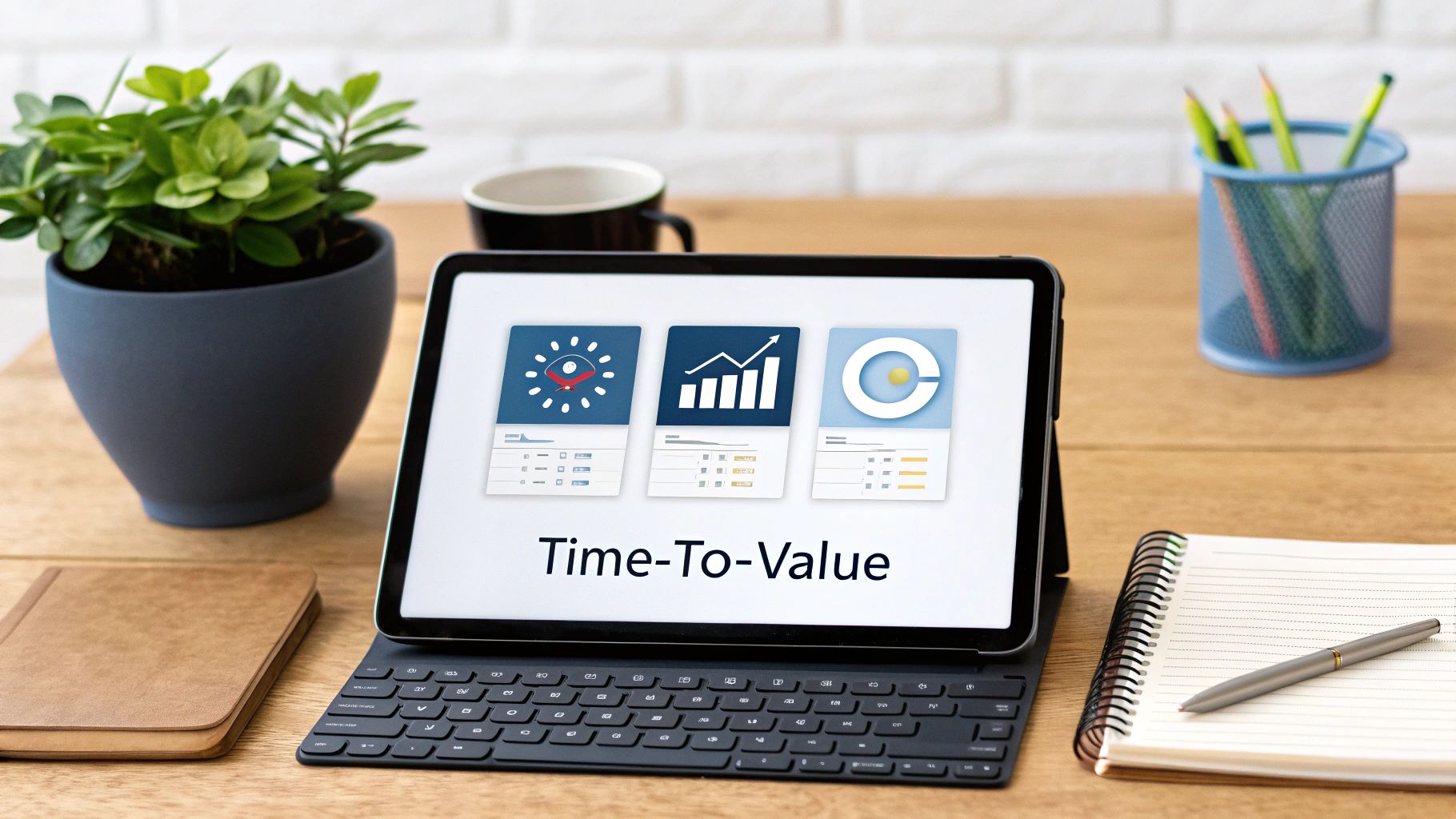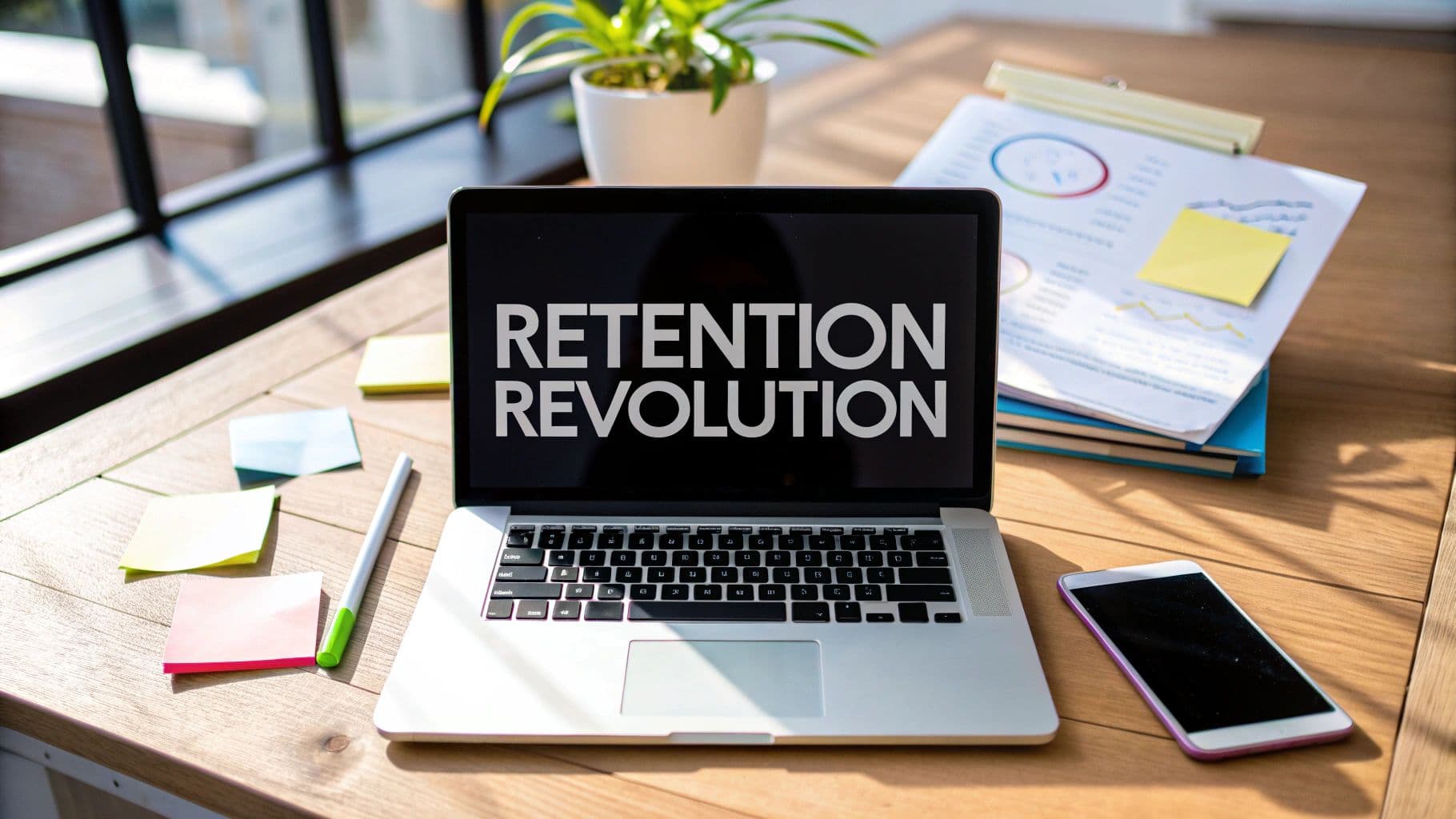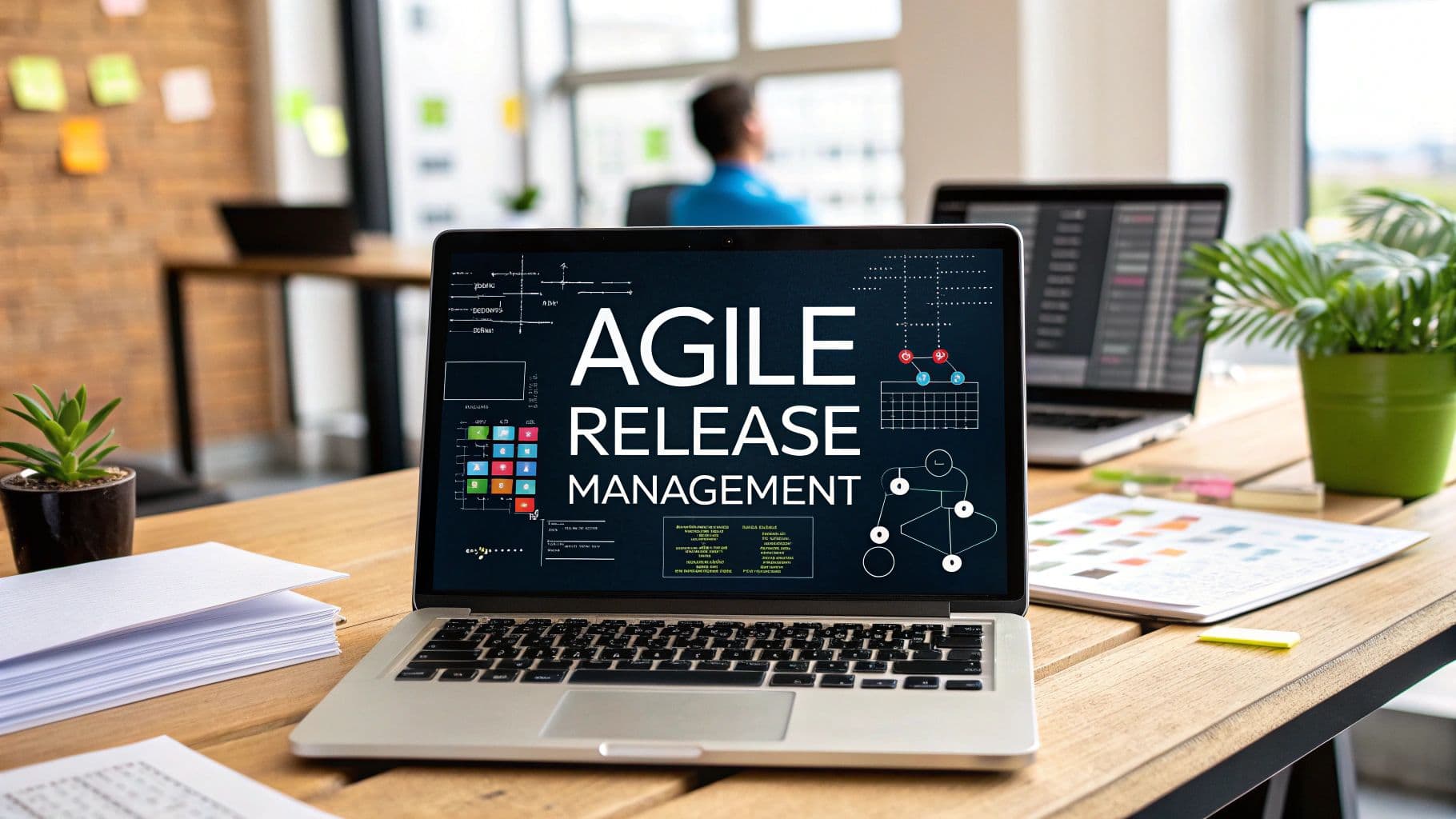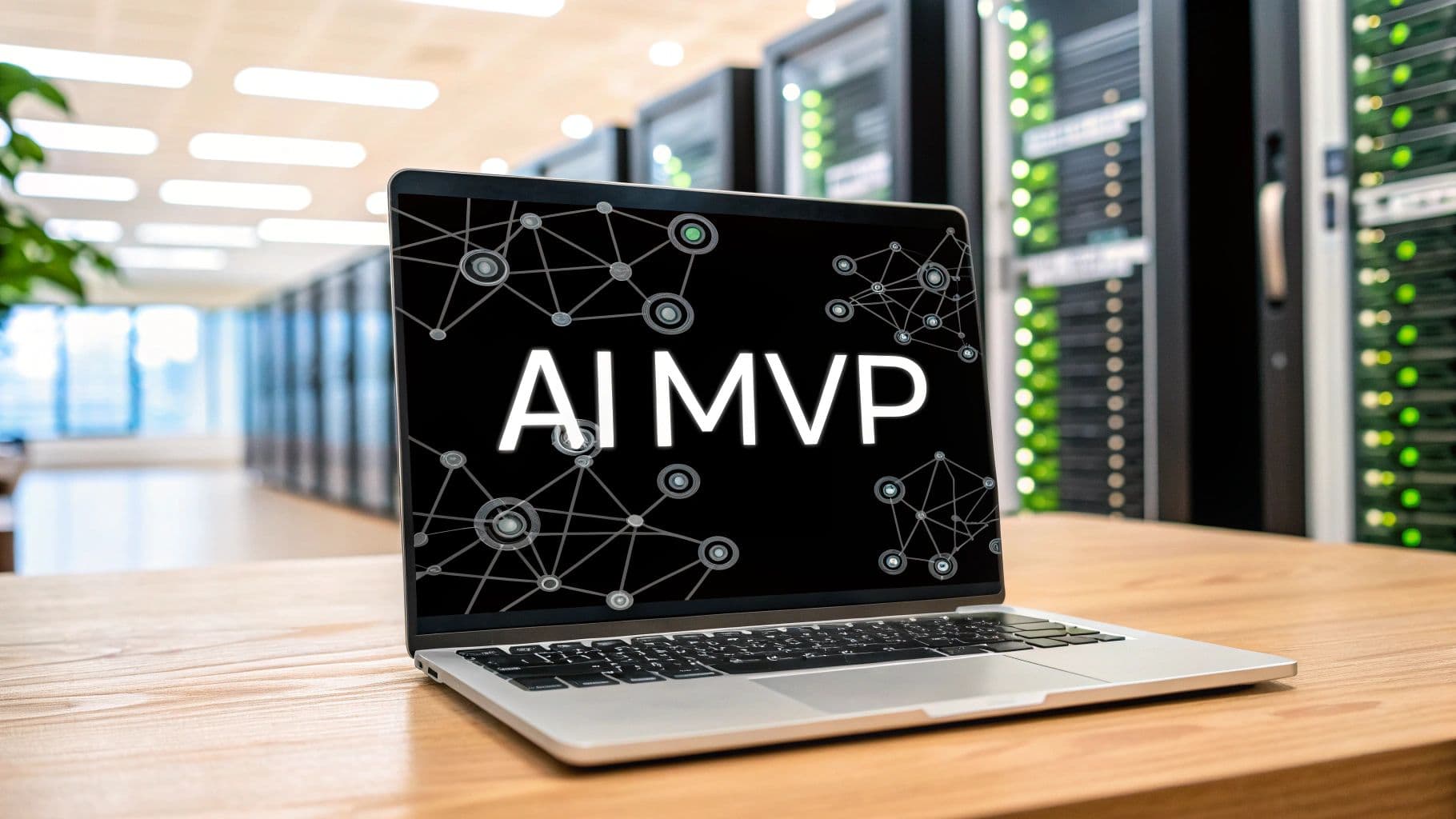saas retention strategies
customer retention
saas churn
product led growth
customer success
8 SaaS Retention Strategies That Actually Work in 2025
Beyond the Hype: Why Your SaaS Needs a Retention Revolution
In the competitive Software as a Service market, acquiring new customers often takes the spotlight, but the real key to sustainable growth and profitability is keeping the users you have already earned. High customer churn can silently dismantle a SaaS business, eroding its revenue base and hindering long-term valuation. Moving beyond generic advice is essential for building a resilient company. This requires a focused and proactive approach to customer retention, transforming it from an afterthought into a core business function.
This article provides a comprehensive roundup of eight powerful, field-tested SaaS retention strategies that leading companies are using to secure their customer base. We will go beyond surface-level tips to provide a detailed blueprint for each strategy, covering everything from proactive customer success to predictive churn modeling. For those looking to dive deeper into the core mechanics, understanding and addressing proven strategies to retain and grow revenue by addressing churn in SaaS is a critical first step.
You will gain actionable insights and practical implementation steps for each of the following areas:
- Proactive Customer Success Management
- Usage-Based Onboarding and Time-to-Value Optimization
- Feature Adoption and Expansion Campaigns
- Predictive Churn Modeling and Prevention
- Community Building and User Engagement
- Personalized Retention Marketing and Communication
- Value-Based Pricing and Packaging Optimization
- Integrated Customer Feedback and Product Development Loop
Whether you are a startup founder aiming to build a sticky product from the ground up or a product manager at an established company looking to fortify your user base, this guide will equip you with the tools needed to build a loyal customer base that not only stays but actively grows with your platform. Let’s explore the modern strategies that will revolutionize your approach to retention and drive lasting success.
1. Proactive Customer Success Management
Proactive Customer Success Management is one of the most powerful SaaS retention strategies available because it fundamentally shifts your relationship with customers from reactive problem-solving to proactive value creation. Instead of waiting for a support ticket, a dedicated Customer Success Manager (CSM) actively monitors user health, anticipates needs, and guides customers toward achieving their desired outcomes with your product. This transforms the customer relationship into a strategic partnership focused on mutual growth, making your platform indispensable.

Pioneered by thought leaders like Lincoln Murphy and operationalized by companies like Gainsight, this approach centers on one core idea: the customer's success is your success. A proactive framework ensures users are not just using your software but are deriving maximum, tangible value from it. For example, Slack’s customer success teams analyze workspace usage patterns to identify power users for advocacy programs or spot teams with dropping engagement, allowing them to intervene with targeted training before the account churns. Similarly, Salesforce's success managers conduct regular business reviews to align the platform’s capabilities with the customer's evolving business goals.
How to Implement Proactive Customer Success
This strategy is most effective for B2B SaaS companies with a high customer lifetime value (LTV), where the investment in dedicated CSMs yields a significant return. It's particularly crucial during and after onboarding to prevent early churn and drive deep product adoption.
Here are actionable steps to build a proactive function:
- Implement Customer Health Scoring: From day one, track key metrics that indicate a customer's health. This could include product usage frequency, feature adoption rates, number of support tickets, and even survey responses. Use a simple RAG (Red-Amber-Green) status to trigger CSM actions.
- Define Success Milestones Jointly: Work with new customers to define what success looks like for them within the first 30, 60, and 90 days. These "Success Plans" create a clear roadmap and hold both parties accountable.
- Create CSM Playbooks: Don't leave interventions to chance. Develop standardized playbooks for common scenarios like low user adoption, key contact departure, or a poor health score. These guides outline the exact steps a CSM should take, ensuring consistent and effective outreach.
- Leverage Automation for Scale: Use CRM or customer success platforms to automate alerts and low-touch check-ins. For instance, automatically trigger an email with a helpful guide when a customer uses a new feature for the first time, allowing CSMs to focus on high-impact, strategic conversations.
2. Usage-Based Onboarding and Time-to-Value Optimization
Usage-Based Onboarding is a critical SaaS retention strategy that focuses on systematically guiding new users to experience the core value of your product as quickly as possible. The goal is to dramatically shorten the "Time-to-Value" (TTV), the period between a user's signup and their first "Aha!" moment. Instead of a generic product tour, this approach delivers a structured, personalized journey that celebrates small wins and progressively introduces features, preventing overwhelm and building momentum toward deep adoption.

Popularized by experts like Samuel Hulick of UserOnboard.com and Wes Bush, this product-led methodology recognizes that early value realization is the single best predictor of long-term retention. For example, Canva doesn't start with a blank canvas; it presents users with templates, guiding them to create a professional-looking design in minutes. Similarly, Airtable encourages new users to select a pre-built base template for a specific use case, allowing them to see the platform's power immediately rather than building a complex database from scratch. This focus on an immediate, tangible outcome makes the product feel indispensable from day one.
How to Implement Usage-Based Onboarding
This strategy is vital for any SaaS business, but especially for those with a product-led growth (PLG) model, where the product itself is the primary driver of acquisition, conversion, and expansion. It directly combats early-stage churn by ensuring users don't get lost or frustrated.
Here are actionable steps to optimize your onboarding for faster TTV:
- Map the "First Strike" User Journey: Analyze the exact steps a user must take to achieve their first key outcome. Identify every point of friction or confusion and ruthlessly eliminate it. For a practical guide to optimizing this initial user experience, refer to this comprehensive SaaS Onboarding Checklist.
- Use Progressive Disclosure: Don't show users every feature at once. Introduce functionality contextually as they complete key actions. This "learn by doing" approach reduces cognitive load and makes the product feel more intuitive.
- Celebrate Small Wins: Use in-app messages, checklists, or even confetti animations to acknowledge when a user completes a critical setup task or reaches a milestone. This positive reinforcement builds confidence and encourages further exploration.
- Personalize Onboarding Flows: Segment users by role, use case, or company size to deliver a tailored onboarding experience. A marketer using your tool needs a different starting point than a developer, and your onboarding should reflect that. For advanced insights, learn more about AI-driven personalized learning paths.
3. Feature Adoption and Expansion Campaigns
Feature Adoption and Expansion Campaigns are among the most effective SaaS retention strategies because they directly increase a customer's investment and reliance on your platform. This approach moves beyond basic usage and strategically guides users to discover and integrate more advanced or complementary features into their workflow. By deepening their product engagement, you create "stickier" customers who see your software not just as a tool for one task, but as an essential, multi-faceted solution for their broader needs. This significantly raises the switching costs and reinforces long-term value.

Popularized by growth leaders like Brian Balfour and Elena Verna, this strategy is built on the principle that increased feature adoption is a leading indicator of retention and expansion revenue. When customers utilize more of your product, they solve more of their problems, making your platform indispensable. For instance, Dropbox successfully introduced its "Paper" feature to its massive base of storage users, creating a new layer of collaborative value. Similarly, Atlassian masterfully cross-promotes Confluence to Jira users, demonstrating how documentation and project management can work together seamlessly, thereby embedding both products deeper into a company's operations.
How to Implement Feature Adoption Campaigns
This strategy is vital for SaaS companies with multi-feature products or tiered pricing plans. It is most effective when targeted at established users who have mastered the core functionality and are ready to unlock more value. The goal is to drive progressive discovery, not overwhelm new users.
Here are actionable steps to drive feature adoption:
- Segment Users by Behavior: Group your customers based on their current usage patterns. Identify power users of a specific feature and target them with campaigns for a complementary one. Conversely, identify users who haven't touched a key feature and create a targeted educational drip campaign.
- Use Contextual, In-App Messaging: Avoid generic pop-ups. Instead, trigger messages based on user actions. When a user completes a task that could be enhanced by another feature, use a subtle tooltip or modal to introduce it. Slack does this well by prompting users to create channels or use threads based on conversation patterns.
- Craft a Clear Value Proposition: Don't just announce a feature; sell its benefit. Frame your communication around the problem it solves or the outcome it enables. Instead of saying "Try our new reporting dashboard," say "Get instant insights into your team's performance without exporting data."
- Track Adoption as a Key Health Metric: Integrate feature adoption rates into your customer health scores. A customer who adopts a new, sticky feature has a much higher likelihood of retaining. Monitor this data to proactively identify both at-risk accounts and expansion opportunities.
4. Predictive Churn Modeling and Prevention
Predictive Churn Modeling and Prevention elevates SaaS retention strategies from reactive to preemptive by using data science to forecast which customers are likely to cancel their subscriptions. This approach leverages machine learning algorithms and behavioral analytics to sift through vast amounts of data, including historical usage, feature adoption rates, support ticket history, and engagement metrics. By identifying at-risk customers before they churn, you can launch targeted intervention campaigns designed to re-engage them and demonstrate your product's ongoing value.

The power of this strategy is championed by industry leaders like Patrick Campbell of ProfitWell, whose company developed tools like Retain to automate churn reduction. The concept is simple: data holds the clues to future behavior. For instance, Netflix famously analyzes viewing patterns to predict subscription cancellations, while Spotify tracks engagement metrics to flag users who might be drifting away. In the B2B space, a company like Zendesk can analyze support ticket sentiment and resolution times to predict account health, allowing them to proactively address friction points. These models transform raw data into actionable intelligence.
How to Implement Predictive Churn Modeling
This strategy is ideal for SaaS companies with a substantial volume of user data, where patterns can be statistically identified. While complex machine learning models require data science expertise, simpler versions can be implemented to great effect, making it one of the most scalable SaaS retention strategies. One of the most critical aspects of a robust retention strategy involves understanding and actively implementing effective strategies for reducing churn rate.
Here are actionable steps to get started:
- Combine Multiple Data Sources: For maximum accuracy, your model should draw from various inputs. Integrate product analytics (e.g., login frequency, key feature usage), CRM data (e.g., contract renewal date, plan tier), support data (e.g., ticket volume, satisfaction scores), and financial data (e.g., payment failures).
- Start Simple and Iterate: You don't need a perfect, complex AI model from day one. Begin with a simple rules-based system or a logistic regression model based on a few key indicators, like a drop in logins for 30 consecutive days. Refine and enhance the model as you collect more data and learn what correlates with churn.
- Focus on Actionable Insights: The goal isn't just to predict churn but to prevent it. Ensure your model's output is easily understood by your customer success or marketing teams. A churn probability score of 85% is only useful if it triggers a specific, pre-defined intervention playbook.
- Train Teams to Act on Predictions: Equip your customer-facing teams with the training and tools to act on these predictions. When the model flags an account, the CSM should know exactly what steps to take, whether it's scheduling a strategic business review, offering targeted training, or presenting a new feature that solves an emerging pain point.
5. Community Building and User Engagement
Community Building and User Engagement is a retention strategy that creates a powerful moat around your product by fostering a space where customers can connect, share best practices, and support one another. This approach transforms your user base from a collection of individual accounts into an interconnected network. By facilitating peer-to-peer interaction, you add a layer of value that exists outside the core product features, making your platform a hub for professional growth and knowledge exchange, which significantly increases switching costs.
Pioneered by community strategists like David Spinks and Richard Millington, this philosophy proves that the connections between users can be as valuable as the connection a user has with the software itself. Salesforce's Trailblazer Community, with millions of members, is a prime example, providing a space for users to earn badges, find answers, and network. Similarly, Figma’s Community allows designers to share files, plugins, and templates, creating a self-perpetuating ecosystem of value that strengthens user loyalty and drives organic product adoption.
How to Implement Community and User Engagement
This strategy is highly effective for SaaS products that have a steep learning curve, a creative or collaborative use case, or a passionate user base. It builds a powerful support system that reduces the burden on your official support channels and provides invaluable, direct feedback for your product roadmap. For more insights on leveraging digital platforms for community, check out these B2B SaaS opportunities in social media.
Here are actionable steps to build a thriving user community:
- Seed the Community with Power Users: Don't launch an empty forum. Identify your most engaged customers and invite them to be founding members. Their initial activity will set a positive tone and create the critical mass needed to attract other users.
- Provide a Clear Value Proposition: Users need a reason to participate. Clearly articulate what they will gain, whether it's exclusive access to product experts, early access to new features, peer-to-peer support, or networking opportunities with industry leaders.
- Invest in Dedicated Community Management: A community needs a leader. Hire a dedicated community manager to moderate discussions, facilitate connections, create content, and act as the bridge between the users and your company.
- Recognize and Reward Top Contributors: Implement programs that highlight and reward your most active members. This can be as simple as a "top contributor" badge, exclusive swag, or invitations to special events. This recognition encourages continued participation and fosters a culture of helpfulness.
6. Personalized Retention Marketing and Communication
Personalized Retention Marketing and Communication is a cornerstone of modern SaaS retention strategies, moving beyond generic mass emails to deliver highly relevant, timely messages tailored to individual user behavior and lifecycle stage. Instead of blasting your entire user base with the same promotion, this approach uses segmentation and behavioral triggers to create meaningful, one-to-one touchpoints. This makes users feel seen and understood, transforming your communication from an interruption into a valuable service that strengthens loyalty and prevents churn.
This strategy, advocated by marketing leaders like Hiten Shah and Ann Handley, recognizes that personalization is a key driver of engagement. The goal is to send the right message to the right user at the right time. For example, Duolingo's famous streak reminders are triggered by a user's inactivity, providing a personalized nudge to maintain their progress. Similarly, Spotify excels by using listening data to create customized "Discover Weekly" playlists, making the platform feel indispensable and uniquely tailored to each user's taste. Intercom also uses this by sending targeted in-app messages to users who haven't adopted a key feature yet, guiding them toward greater value.
How to Implement Personalized Retention Marketing
This strategy is effective for SaaS businesses of all sizes, especially those with a large user base where one-to-one human interaction isn't scalable. It is crucial for re-engaging at-risk users, driving feature adoption, and encouraging upgrades at opportune moments.
Here are actionable steps to build a personalized communication engine:
- Segment Users Based on Behavior: Move beyond simple demographics. Create dynamic segments based on product usage, such as "power users," "inactive users," "users who haven't tried X feature," or "users nearing a plan limit." This allows for hyper-relevant messaging.
- Establish Behavioral Triggers: Set up automated communication workflows based on specific user actions (or inactions). For example, send a congratulatory email when a user reaches a milestone or a helpful guide when they repeatedly visit a specific feature's help page.
- Use Progressive Profiling: Don't ask for all user information at once. Gradually collect data through interactions over time. Ask for their role after they've used the product for a week or their team size when they invite a colleague, allowing for deeper personalization later. Learn more about how AI can help create a personalized customer experience.
- Respect Communication Preferences: Allow users to easily manage their notification settings. Giving them control over what messages they receive and on which channels (email, in-app, push) builds trust and reduces the chance they'll unsubscribe from everything.
7. Value-Based Pricing and Packaging Optimization
Value-Based Pricing is a sophisticated SaaS retention strategy that ties the cost of your product directly to the value customers receive from it. Instead of pricing based on features or competitor rates, this model aligns your revenue with your customers' success. By structuring tiers and packages around key value metrics, you create a system where customers happily pay more as they achieve better outcomes, making your pricing feel fair and justified. This transforms pricing from a point of friction into a tool for mutual growth, reducing churn driven by poor price-to-value perception.
This approach, championed by pricing experts like Patrick Campbell of ProfitWell, argues that how you price is a powerful lever for retention. A well-designed value-based model ensures you never overcharge a small user or undercharge a power user. For instance, Mailchimp’s contact-based pricing ties cost to the customer's audience size, a clear indicator of value for an email marketing platform. Similarly, Slack’s per-active-user model ensures companies only pay for employees who are actually using and benefiting from the tool, a structure that feels inherently fair and promotes adoption.
How to Implement Value-Based Pricing
This strategy is ideal for SaaS companies whose products deliver measurable, scalable outcomes for customers. It works best when you can identify a clear "value metric" that grows as the customer's business grows. It's a critical component of a holistic retention strategy that aligns product, marketing, and sales around customer success.
Here are actionable steps to optimize your pricing and packaging:
- Research Customer Value Metrics: Conduct thorough research, including surveys and interviews, to identify what your customers value most. Is it the number of contacts, projects managed, transactions processed, or data stored? This metric should be the cornerstone of your pricing tiers.
- Test Pricing Changes Incrementally: Never roll out a major pricing overhaul to your entire user base at once. Test new models with small, specific customer segments or new sign-ups first. Analyze the impact on conversion, adoption, and initial churn before making a wider change.
- Provide Granular Usage Visibility: Build a dashboard or reporting feature that gives customers clear visibility into their usage of the value metric. This transparency helps them understand their bill and see the direct connection between cost and the value they are receiving.
- Communicate Pricing Changes Proactively: When you do adjust pricing, communicate the changes and the reasons behind them well in advance. Frame the update around the added value you’re providing, and consider grandfathering existing loyal customers into their old plans for a period to soften the impact.
8. Integrated Customer Feedback and Product Development Loop
An Integrated Customer Feedback and Product Development Loop is a systematic process that turns customer insights into a core driver of product evolution. Instead of treating feedback as a reactive support function, this strategy creates a continuous, closed-loop system where user suggestions, complaints, and needs are actively collected, analyzed, and used to inform the product roadmap. This makes customers feel heard and valued, transforming them into co-creators of the product and making your platform more aligned with their real-world challenges.
This methodology, heavily influenced by the work of Steve Blank (customer development) and Eric Ries (Lean Startup), is about building what customers will actually use and pay for. For instance, Slack's evolution from a gaming company's internal tool to a communication giant was fueled by acting on feedback, leading to beloved features like threaded conversations and shared channels. Similarly, Notion’s public roadmap and community-driven feature voting system give users direct influence over development, fostering immense loyalty and creating a product that precisely meets its power users' needs. This is one of the most powerful SaaS retention strategies because it directly addresses user pain points before they become reasons to churn.
How to Implement a Feedback and Development Loop
This strategy is vital for all SaaS companies, but especially those in competitive markets where product-market fit is constantly evolving. It is most impactful when embedded into the company culture, from engineering to marketing, ensuring the customer's voice guides strategic decisions.
Here are actionable steps to build an integrated loop:
- Create Multiple Feedback Channels: Don't rely on a single source. Combine in-app feedback widgets (like Hotjar or UserVoice), customer support conversations, NPS surveys, and community forums. This ensures you capture input from different user segments, from silent power users to vocal new customers.
- Prioritize Feedback Based on Retention Impact: Not all feedback is equal. Create a framework to score requests based on factors like the number of users requesting it, the LTV of those users, and its alignment with your strategic vision. Focus on solving problems that cause the most friction and churn.
- Close the Loop Explicitly: When you ship a feature based on feedback, communicate it. Send targeted emails to the users who requested it, post updates in your community, and write a blog post explaining the "why." This simple act validates their contribution and reinforces their decision to stick with you.
- Involve Customers in the Process: Invite engaged users to become beta testers for new features. This not only provides invaluable pre-launch feedback but also strengthens your relationship with your most important customers, turning them into passionate advocates.
SaaS Retention Strategies Comparison Matrix
| Strategy | Implementation Complexity 🔄 | Resource Requirements 💡 | Expected Outcomes 📊 | Ideal Use Cases 💡 | Key Advantages ⭐ |
|---|---|---|---|---|---|
| Proactive Customer Success Management | High - requires dedicated teams and tools | High - specialized staff and sophisticated tracking | Prevents churn, increases lifetime value, stronger relationships | Best for high-touch customer segments and enterprise clients | Preemptive churn prevention, drives expansion |
| Usage-Based Onboarding and Time-to-Value Optimization | Medium-High - involves multi-step flows and testing | Medium - UX/UI, product and data resources | Faster time to value, reduces early churn, higher engagement | New user onboarding and trial-to-paid conversion optimization | Accelerates adoption, improves early engagement |
| Feature Adoption and Expansion Campaigns | Medium - needs segmentation and messaging | Medium - content creation and analytics | Increased product stickiness, expansion revenue, reduced churn | Expanding usage within existing customer base | Drives upsell & deeper engagement |
| Predictive Churn Modeling and Prevention | Very High - requires data science expertise | High - data, analytics, ML models, ongoing refinement | Proactive retention, efficient resource allocation, data-driven insights | Large datasets, SaaS with churn issues | Scalable, predictive intervention capability |
| Community Building and User Engagement | Medium - continuous management and moderation | Medium - community managers and platform tools | Emotional attachment, peer support, advocacy, feedback | Products benefiting from network effects and user collaboration | Builds brand loyalty, reduces support costs |
| Personalized Retention Marketing and Communication | High - complex automation and data needs | High - marketing automation, analytics | Higher engagement and conversion, improved satisfaction | Customer lifecycle marketing and behavior-triggered campaigns | Relevant, timely messaging improves retention |
| Value-Based Pricing and Packaging Optimization | High - requires pricing strategy and systems | Medium-High - pricing expertise and billing systems | Aligns price with value, reduces price churn, clear upgrade paths | Pricing optimization for SaaS and usage-based billing | Increases customer lifetime value through fair pricing |
| Integrated Customer Feedback and Product Development Loop | Medium-High - requires cross-team coordination | Medium - feedback systems and product teams | Customer-driven improvements, stronger relationships, competitive edge | Continuous product improvement and customer-centric design | Builds product-market fit and customer loyalty |
Weaving Your Retention Strategy into a Cohesive Whole
Throughout this guide, we've explored eight powerful SaaS retention strategies, from proactive customer success to integrated feedback loops. Each strategy, whether it’s optimizing your onboarding to accelerate time-to-value or leveraging predictive models to preemptively engage at-risk users, holds the potential to significantly decrease churn. However, viewing these tactics as a disconnected checklist is a common pitfall that limits their true impact. The real breakthrough occurs when you stop treating retention as a series of isolated actions and start architecting a unified, holistic system.
The most resilient and profitable SaaS businesses understand that these strategies are not independent silos. They are interconnected gears in a single, well-oiled customer-centric engine. Think about the powerful synergies: your predictive churn model doesn't just flag a user; it triggers a workflow for your proactive customer success manager to reach out with a personalized retention marketing offer, perhaps highlighting a newly launched feature they haven't adopted yet. That new feature, in turn, was born from insights gathered through your integrated customer feedback loop, which also informed a recent adjustment to your value-based pricing tiers. This is how you create a seamless experience where every touchpoint reinforces value and strengthens the customer relationship.
From Theory to Action: Your Next Steps
Moving from understanding these SaaS retention strategies to implementing them can feel daunting. The key is to start small and build momentum. Don't attempt to overhaul everything at once. Instead, adopt a focused, incremental approach.
1. Diagnose Your Biggest Leak: Begin by analyzing your data. Where is your churn most acute? Is it within the first 30 days, suggesting an onboarding or time-to-value problem? Or are long-term customers leaving, pointing to a need for better feature adoption campaigns or community engagement? Pinpoint the single biggest point of friction in your customer lifecycle.
2. Implement One High-Impact Strategy: Concentrate your resources on the one strategy that directly addresses your biggest leak. For example:
- If early churn is high: Dedicate your next sprint to overhauling your onboarding, focusing on usage-based triggers and celebrating small wins.
- If engagement is dropping off: Launch a targeted campaign to drive adoption of a key, sticky feature that correlates with long-term retention.
- If you lack customer insights: Implement a simple, automated system for collecting feedback at key moments, such as after a support interaction or when a user cancels their subscription.
3. Measure, Iterate, and Expand: Once you've implemented your initial strategy, rigorously track its impact on your key retention metrics. Use these learnings to refine your approach. As you see success and free up resources that were previously spent acquiring new customers to replace churned ones, you can begin layering in the next complementary strategy. For instance, after improving onboarding, you can start building a community for your now more-engaged users.
The End Goal: Building a Retention-First Culture
Mastering these SaaS retention strategies is about much more than just keeping your churn rate low. It's about fundamentally shifting your company's focus from acquisition-at-all-costs to building sustainable, long-term value. A retention-first culture creates a powerful flywheel effect. Happy, successful customers are more likely to upgrade, expand their usage, and become vocal advocates for your brand, ultimately fueling more efficient and organic growth. They become your best marketing channel and your most valuable asset.
By committing to weaving these strategies into the very fabric of your operations, you are not just plugging holes in a leaky bucket. You are forging a resilient, profitable business built on a foundation of deep customer loyalty and continuous, validated improvement.
Building robust product features and feedback loops is central to many of these retention strategies. If you're looking to rapidly prototype and deploy AI-powered features without getting bogged down in boilerplate code, AnotherWrapper can help you ship faster. It provides a simple, effective way to manage your LLM API calls, allowing you to focus on creating the value that keeps your users coming back.
Fekri




